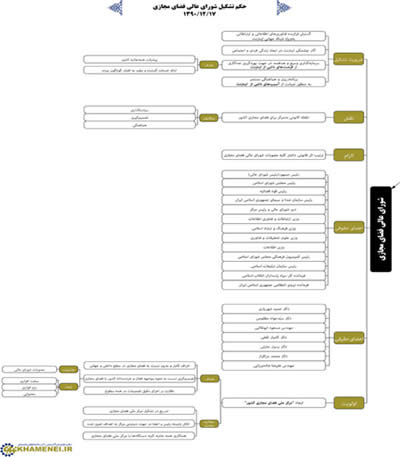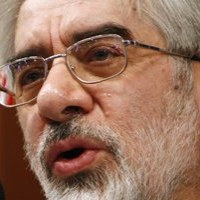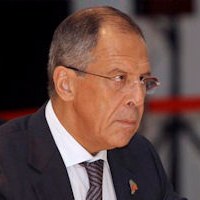![]()
Sun, March 18, 2012
First published in The Meir Amit Intelligence and Terrorism Information Center’s bulletin number 161: ‘Cyberspace comes under increasing control: Supreme Leader orders establishment of “Supreme Cyber Council”’
Last Wednesday, March 7, Supreme Leader Ayatollah Ali Khamenei issued a new directive on the establishment of a “Supreme Cyber Council”. The directive says that the decision to establish the council was made in response to the growth of information and telecommunications technology, particularly the global internet network, and its impact on individual and social life. Other factors behind the establishment of the council are the need to facilitate the most effective possible use of the opportunities inherent in technological progress for the advancement of public services, and the need to step up planning and integration of efforts to prevent damage that can be caused by the growing use of cyberspace.

The Supreme Leader’s directive on the establishment of the Supreme Cyber Council, as it appeared on his official website.
Headed by the president, the council members will include the Majles chairman, the chief of the judiciary, the head of Iran Broadcasting, the ministers of telecommunications, Islamic guidance, intelligence, and science, the chairman of the Majles Culture Committee, the chairman of the Islamic Propagation Organization, the chief of the Revolutionary Guards, the commander of the internal security forces, as well as seven experts on internet and information technology.
The new council has been instructed to promptly establish a “National Cyber Center” to be in charge of all cyber activities in Iran and elsewhere, which includes issues of software, hardware, and internet content. The center will also supervise the implementation of decisions made with regard to these issues. The Supreme Leader instructed all government institutions to cooperate with the new center.
Seyyed Mehdi Khamoushi, chairman of the Islamic Propagation Organization, discussed the need for the establishment of the new council. In an article published on the Supreme Leader’s official website, Khamoushi said that Iran’s enemies consider the “soft war” and the cultural attack on Iran to be the most important struggle intended to undermine the Islamic revolution. Iran needs to protect its philosophical, religious, and cultural borders, and take advantage of cyberspace to send out its message to the world and fight against the messages sent by its enemies.
Iran is facing a “tsunami of information”, which is why it needs a concerted effort to deliver its messages and deal with the efforts made by its enemies in this field. Iran is also facing a technological progress that can be harnessed to provide more effective social and government services and improve the relationship between the administration and the public.
The chairman of the Islamic Propagation Organization noted that, in recent years, experts, culture figures, clerics, and scientists have communicated their concerns about cyberspace to the Supreme Leader, and that the new council will be tasked with formulating ideas and plans in fields pertaining to the internet and information technology. These ideas will then be presented to the Supreme Leader (www.khamenei.ir, March 8).
Dr. Kamyar Saqafi, who has been appointed to the council, said that cyberspace cannot be the responsibility of just one government ministry, and that it requires coordination between many different bodies. Different models used so far to formulate policies on information technology were insufficient, as the field requires a broader outlook. Saqafi said that the composition of the council shows how important this issue is for the Supreme Leader (Mehr, March 10).
The establishment of the Supreme Cyber Council was widely covered by Iranian media and was even addressed by Ayatollah Ahmad Jannati, the Friday prayer leader in Tehran. Jannati, who serves as chairman of the Guardian Council, said that the establishment of the council is an indication of the attention given by the Supreme Leader to issues others tend to dismiss. Jannati noted that cyberspace makes it possible for secrets to be stolen, and that the internet poses a considerable threat to world nations and is intended to create insecurity in the world (Fars, March 10).
On the margins of the extensive media coverage about the council’s establishment, the composition of the council was criticized by an Iranian blogger. In a post made by Ali Pour-Tabataba’i on his personal blog, the blogger said that while in principle he does support the establishment of the council, he has several reservations about its activity and composition, which may, in his view, weaken its ability to solve the severe problems that exist in Iranian cyberspace.
The blogger expressed his concern that the establishment of the council will undermine the Majles’ authority and its ability to pass new laws pertaining to cyberspace. He noted that similar councils established in the past, such as the Supreme Council of the Cultural Revolution, saw themselves above all other branches of government and as having powers not subject to any kind of control. For instance, laws passed on the initiative of the Supreme Council of the Cultural Revolution could not be changed even by the Guardian Council or the Expediency Discernment Council.
In addition, the blogger said that the composition of the council will not allow it to be in charge of both content issues and technology issues involving cyberspace. He noted that most council members are engineers or technical experts. The council has no experts on social sciences or humanities, and no senior representative from the religious seminaries who could speak for top clerics and religion students.
The presence of representatives from the Revolutionary Guards, the Ministry of Intelligence, and the internal security forces is similarly problematic, Pour-Tabataba’i said, since it can prompt the council to adopt a “security-oriented approach”. Such an approach considers every online activity a conspiracy that has to be combated. If this approach is adopted by the new council, the result may be an escalation of the struggle already waged on “cyberspace activists”. This struggle has already provoked dissatisfaction from cyber activists who support the Islamic republic, according to Pour-Tabataba’i.
Finally, the blogger warned that the establishment of the new council will make it even more difficult to solve currently existing problems with cyberspace. Instead of scaling back the agencies involved in the field, the council may become a new bloated and inefficient government center that will provide no solution to the demands brought up by the Supreme Leader (http://www.kheyzaranonline.ir/1390/12/18/supreme-council-of-cyberspace-affect-all-irans-cyber-space).
As the authorities tighten their control of the internet, this week Telecommunications Minister Reza Taqipour once again addressed the threats posed by the network, and the intent to create a national intranet. In an interview given to ISNA News Agency, the minister said that the intranet will operate separately from the global internet network and will make it possible to transfer information securely, which is currently impossible with the global network. He added that the creation of the national information network requires the cooperation of the public and private sectors (ISNA, March 10).
At a meeting with his Iraqi counterpart, Taqipour said that Western countries, particularly the United States, use the internet for spying and spreading corruption, but that Iran has launched activities designed to manage the use of the internet and limit its abuse. The internet should serve all countries in the world, not just the West, which uses it for its economic needs and for harming other countries, the minister said (Fars, March 10).
Meanwhile, this week the Iranian Center for Statistics published information on internet penetration and web surfing habits in Iran for 2010-2011. According to the information, during the period in question, the internet penetration rate reached 18.9 percent in urban areas and 4 percent in rural areas. A total of 11 million Iranians accessed the internet.
According to the data, 83.8 percent of all web surfers in Iran still use a dial-up connection, 13 percent use ADSL, and 0.9 percent have wi-fi.
About 4.3 million of the 20.3 million families in Iran (21.4 percent) have an internet connection at home: 94 percent of families living in urban areas and only 6 percent of families living in rural areas. Among urban families 91.5 percent have a personal computer at home, compared to 12 percent of families in rural towns and villages.
6.4 million (58.1 percent) of Iran’s web users are men and 4.6 million (41.9 percent) are women. 16.6 percent of Iran’s male population use the internet, compared to 7.12 percent of the female population.
0.4 percent of internet users are less than 10 years old, 26 percent are 10-19, 43.2 percent are 20-29, 21 percent are 30-44, 8.7 percent are 45-64, and 0.5 percent are over 65.
75.2 of internet users surf the web at home, 22.4 percent use internet cafés, 14.4 percent surf at work, 13.4 percent surf at school, 4.3 percent use cellular telephones, 3.9 percent surf at other people’s houses, and 1.4 percent surf in libraries.
26.1 percent of internet users access the web at least once a day, 33.1 percent at least once a week but not every day, 26.6 percent at least once a month but not every week, and 14.1 percent access the web less than once a month (Alef, March 11).



 RSS
RSS










Latest Comments
Hello Mike, Thank you for your positive feedback to the article. I felt there wasn’t too much critical analysis of ...
Thanks for this considered and well constructed article. A follow up article on the manner in which the editorial contro...
THE CLUELESSNESS OF CLAIMING THAT OBAMA'S MIDDLE EAST POLICIES WERE A FAILURE CANNOT BE FURTHER FROM THE TRUTH, WHAT THE...
As long as Obama is the president of the usa do not trust the us government......
Thank you for an good read....